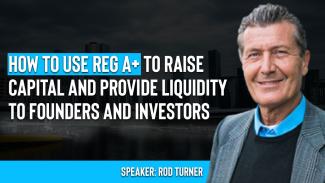
As the CEO of the Manhattan Street Capital investment platform and advisory service specializing in Regulation A+, I help many companies with their Reg A+. I have conducted many webinars advising companies on how to use Reg A+, which requires me to understand the success and failure of offerings as they happen. These experiences--coupled with my background as a serial entrepreneur, my involvement as a senior executive for two NASDAQ IPOs (TATE and Symantec), and a long history of investing in and raising capital for startup companies--have put me in an excellent position to understand what works in Reg A+.
1. Only make a Reg A+ offering if consumers love what you do: Reg A+ works best for companies that appeal deeply to consumers because consumers are early adopters and will invest if they love what your company does. Many companies that do not inherently appeal to consumers have tried Reg A+ anyway. This is the single most significant cause of failed Reg A+ offerings. Ensure that Regulation A+ is a good fit for your company before moving forward. Ideally suited categories for Regulation A+ are Real Estate, Food and Beverage, Biotech, Cancer treatments, disease vaccines and cures, personal security, medical devices, pain treatment, tech gadgets, IoT, Virtual Reality, Drones, alternative energy, electric vehicles, and consumer AI. If giving a discount on your product to an investor will motivate them, this can help.
2. Make your investment terms appeal to Main Street investors: If you can pay a dividend to your investors, you will significantly broaden the appeal of your offering. Interest payments are already a significant factor in the success of Real Estate offerings in Regulation A+. It is challenging for investors to earn 6 or 8% on capital, so providing this return can make a big difference. If your business generates a strong profit flow that can pay for this approach, your offering could appeal significantly to Main Street investors. You might even bypass the consumer appeal requirement in item #1.
3. Engage a terrific crowd investing marketing agency: Some companies have lost out because they hoped a broker-dealer or an offering platform would do the heavy lifting for them. They learned that is a false hope. Crowd investing is a very specialized field that requires a marketing agency that covers all the bases (meaning PR, advertising, social media, creating a beautiful offering, video production, and more) and utilizes highly cost-effective methods. The best approach is to engage a top-notch Crowd investing marketing agency.- we will introduce you to the right one for your business. Weak early traction leads to failed offerings. Pay for an excellent agency, agree on a budget, and manage the heck out of the project with our help for maximum success.
4. Don't overestimate what a broker-dealer will do for your offering. There is no requirement to use a Broker-Dealer in a Reg A+ offering. In almost all cases, broker-dealers will only make an effort to raise capital when investment momentum has already been generated by our efforts through online advertising. Broker-dealer representatives are not willing to risk their relationship with their clients until we prove the offering is already successful.
5. Ensure a short stay in TestTheWatersTM (or avoid it entirely): It allows you to test the market to determine if your products are interesting enough to make a Reg A+ offering worthwhile. The trouble is that too many companies end up in this informal marketing mode for far too long. If there is a delay in the audit or the SEC filing, and a company is still in “test marketing” mode, it risks losing its earliest and most enthusiastic would-be investors. Stretch the process out for six months, and the impact can be fatal for an offering. To avoid stringing along what could be your most valuable brand ambassadors, plan the timing of these critical events early on so that you have nailed down the project plan before you start marketing the offering and creating enthusiasm among potential investors. It’s easier to create excitement just once, and it costs less.
6. Be paranoid when selecting your auditor. Some audit firms delay the audit and raise their price when it’s too late to switch away from them. Take extra care in selecting your auditor upfront. Getting a big-name auditor does not protect you from this practice. Click here to find out how long your audit will remain valid in the Reg A+ process.
7. Set a low minimum capital raise goal. For offerings raising capital to grow a company, “no-minimum” offerings are allowed by the SEC - this is one of the advantages of Reg A+. Some offerings have been launched with very high minimum funding goals, causing failed offerings because time ran out with the minimum not reached – leading to cancellation and refunds to investors. A low minimum allows an early first closing, which helps to pay for the ongoing marketing cost of the raise. (Of course, if you are raising $30 million to buy a building, then the minimum must be $30 million).
8. Only move forward when you have sufficient cash on hand to make the offering well. About 75% of Reg A+ companies must raise capital to fund their offering before starting. In some cases, companies move forward optimistically with their process anyway with a low-budget approach - a recipe for disaster. Slow early traction causes the rest of the offering to become extremely difficult or impossible. So start early in the process by estimating what you think you’ll need for all the necessary front-end budget items and raise that capital beforehand so you can execute the offering with maximum success. You have to spend money to raise money online.
9. Include international investors: Many companies have restricted themselves to US-only investors. Global investors have fewer exciting investment options and, of course, some companies have a solid international presence or appeal that they can build upon.
10. Keep it simple: Avoid complex investment terms, and keep your offering simple. Remember, you need to appeal to consumers. They understand owning shares of stock, and they like being paid interest. Stick to terms they can quickly recognize and that appeal to them. While it is possible to convey complex deal structures when you can meet one-on-one with each investor, those same terms can kill an offering when the investors are figuring out the deal by reading your offering documents online. Make a simple offering and communicate it clearly so consumer investors can quickly and efficiently invest in large numbers.
11. Set a Low Minimum Amount Per Investor: Part of what makes Reg A+ excellent is that people of any wealth level anywhere on the globe can invest. To engage with the broadest audience of investors, set a low minimum of perhaps $200 to $300. Remember, we need excellent consumer investor traction to get the Broker-Dealer to see the success they need before putting their client relationships on the line. Setting a low minimum requires some careful negotiation with service providers to keep costs in line. The payoff is much greater consumer investor participation, which is so crucial at this stage. And of course, the average investment amount will end up being far more than the minimum anyway – typically 4 to 8 times higher to date for successful deals.
12. Steer clear of Reg A+ Tier 1, make a Tier 2 offering instead: Tier 2 extends from zero up to $75 mill per year. Tier 2 solves the problem of satisfying the various States’ Blue Sky Laws. Each state has a different system, and some are very slow indeed. The only time Tier 1 makes sense is if you can raise all your capital outside the USA or from one or two states that are easy to satisfy for Blue Sky filings. Notably, California is one of the most difficult to qualify for. They require an audit and a Merit Review to judge the risk versus return level of your business so that many early-stage companies cannot get the green light – which is far more complex than the SEC. Tier 1 is more accessible because the SEC does not require an audit or financial results reporting post offering. The cost of satisfying the states could easily double the legal fees of filing with the SEC and could take a year or even be impossible in the Merit Review States - versus 60 days for the SEC filing. It's prolonged and expensive for Tier 1.
In summary, take your time and carefully evaluate how well Regulation A+ fits your company before you get started. If you do move forward, take the time to do it right. Apply these guidelines to maximize the likelihood of your Reg A+ becoming a great success. Keep me posted on your progress to include your success in my Reg A+ updates, and you are welcome to email me at [email protected]
Click here to read a similar article written by Rod Turner for Forbes.
Rod Turner
Rod Turner is the founder and CEO of Manhattan Street Capital, the #1 Growth Capital service for mature startups and mid-sized companies to raise capital using Regulation A+. Turner has played a vital role in building successful companies, including Symantec/Norton (SYMC), Ashton Tate, MicroPort, Knowledge Adventure, and more. He is an experienced investor who has built a Venture Capital business (Irvine Ventures) and has made angel and mezzanine investments in companies such as Bloom, Amyris (AMRS), Ask Jeeves, and eASIC.
www.ManhattanStreetCapital.com
Manhattan Street Capital, 5694 Mission Center Rd, Suite 602-468, San Diego, CA 92108.









